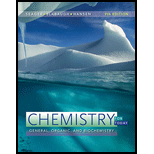
Identify the group and period to which each of the following elements belongs:
a.
b. element number
c. zinc
d. element number
(a)
Interpretation:
The group and period of the element
Concept introduction:
The elements in a modern periodic table are arranged in increasing order of their atomic numbers. In the modern periodic table, the horizontal rows are known as periods and vertical columns are known as groups. There are seven periods and eighteen groups in the modern periodic table.
Answer to Problem 3.1E
The group of the element silicon
Explanation of Solution
The given element
The group and period of the element
(b)
Interpretation:
The group and period of the element number
Concept introduction:
The elements in a modern periodic table are arranged in increasing order of their atomic numbers. In the modern periodic table, the horizontal rows are known as periods and vertical columns are known as groups. There are seven periods and eighteen groups in the modern periodic table.
Answer to Problem 3.1E
The group of the element number
Explanation of Solution
The given element number
The group and period of the element number
(c)
Interpretation:
The group and period of the element zinc is to be stated.
Concept introduction:
The elements in a modern periodic table are arranged in increasing order of their atomic numbers. In the modern periodic table, the horizontal rows are known as periods and vertical columns are known as groups. There are seven periods and eighteen groups in the modern periodic table.
Answer to Problem 3.1E
The group of the element zinc
Explanation of Solution
The given element zinc has a symbol of
The group and period of the element zinc
(d)
Interpretation:
The group and period of the element number
Concept introduction:
The elements in a modern periodic table are arranged in increasing order of their atomic numbers. In the modern periodic table, the horizontal rows are known as periods and vertical columns are known as groups. There are seven periods and eighteen groups in the modern periodic table.
Answer to Problem 3.1E
The group of the element number
Explanation of Solution
The given element number
The group and period of the element number
Want to see more full solutions like this?
Chapter 3 Solutions
Chemistry for Today: General, Organic, and Biochemistry
Additional Science Textbook Solutions
Laboratory Experiments in Microbiology (12th Edition) (What's New in Microbiology)
Applications and Investigations in Earth Science (9th Edition)
MARINE BIOLOGY
Organic Chemistry
General, Organic, and Biological Chemistry - 4th edition
- Identify and provide an explanation of the operational principles behind a Atomic Absorption Spectrometer (AAS). List the steps involved.arrow_forwardInstructions: Complete the questions in the space provided. Show all your work 1. You are trying to determine the rate law expression for a reaction that you are completing at 25°C. You measure the initial reaction rate and the starting concentrations of the reactions for 4 trials. BrO³¯ (aq) + 5Br¯ (aq) + 6H* (aq) → 3Br₂ (l) + 3H2O (l) Initial rate Trial [BrO3] [H*] [Br] (mol/L) (mol/L) | (mol/L) (mol/L.s) 1 0.10 0.10 0.10 8.0 2 0.20 0.10 0.10 16 3 0.10 0.20 0.10 16 4 0.10 0.10 0.20 32 a. Based on the above data what is the rate law expression? b. Solve for the value of k (make sure to include proper units) 2. The proposed reaction mechanism is as follows: i. ii. BrО¸¯ (aq) + H+ (aq) → HBrO3 (aq) HBrO³ (aq) + H* (aq) → H₂BrO3* (aq) iii. H₂BrO³* (aq) + Br¯ (aq) → Br₂O₂ (aq) + H2O (l) [Fast] [Medium] [Slow] iv. Br₂O₂ (aq) + 4H*(aq) + 4Br(aq) → 3Br₂ (l) + H2O (l) [Fast] Evaluate the validity of this proposed reaction. Justify your answer.arrow_forwardе. Д CH3 D*, D20arrow_forward
- H3C. H3C CH 3 CH 3 CH3 1. LDA 2. PhSeCl 3. H2O2arrow_forwardPlease predict the products for each of the following reactions: 1.03 2. H₂O NaNH, 1. n-BuLi 2. Mel A H₂ 10 9 0 H2SO4, H₂O HgSO4 Pd or Pt (catalyst) B 9 2 n-BuLi ♡ D2 (deuterium) Lindlar's Catalyst 1. NaNH2 2. EtBr Na, ND3 (deuterium) 2. H₂O2, NaOH 1. (Sia)2BH с Darrow_forwardin the scope of ontario SCH4U grade 12 course, please show ALL workarrow_forward
- Is the chemical reaction CuCl42-(green) + 4H2O <==> Cu(H2O)42+(blue) + 4Cl- exothermic or endothermic?arrow_forwardIf we react tetraethoxypropane with hydrazine, what is the product obtained (explain its formula). State the reason why the corresponding dialdehyde is not used.arrow_forwarddrawing, no aiarrow_forward

 Introductory Chemistry: A FoundationChemistryISBN:9781337399425Author:Steven S. Zumdahl, Donald J. DeCostePublisher:Cengage Learning
Introductory Chemistry: A FoundationChemistryISBN:9781337399425Author:Steven S. Zumdahl, Donald J. DeCostePublisher:Cengage Learning Chemistry for Today: General, Organic, and Bioche...ChemistryISBN:9781305960060Author:Spencer L. Seager, Michael R. Slabaugh, Maren S. HansenPublisher:Cengage Learning
Chemistry for Today: General, Organic, and Bioche...ChemistryISBN:9781305960060Author:Spencer L. Seager, Michael R. Slabaugh, Maren S. HansenPublisher:Cengage Learning ChemistryChemistryISBN:9781305957404Author:Steven S. Zumdahl, Susan A. Zumdahl, Donald J. DeCostePublisher:Cengage Learning
ChemistryChemistryISBN:9781305957404Author:Steven S. Zumdahl, Susan A. Zumdahl, Donald J. DeCostePublisher:Cengage Learning
 Living By Chemistry: First Edition TextbookChemistryISBN:9781559539418Author:Angelica StacyPublisher:MAC HIGHER
Living By Chemistry: First Edition TextbookChemistryISBN:9781559539418Author:Angelica StacyPublisher:MAC HIGHER





